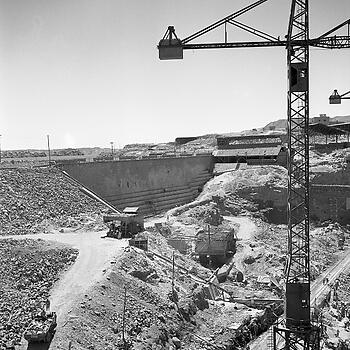Delta Barrage (19th century)
A first major step in regulating the Nile flow was the construction of the Delta Barrages at the two branches of the Niles at the beginning of the 19th century under the ruler and developer Mohamed Ali Pasha (1805-1845), the first leader after the evacuation of the short French colonial era (1798–1802).
Aswan Dam (>1902)
Institutional irrigation development and research also started in this period. The first upstream Aswan Dam was finished in three phases, 1902 (1 billion m3 storage capacity), 1912 (2.5 billion m3), 1932 (5 billion m3). With the construction of the High Aswan Dam, finished in 1972, the storage capacity became 160 billion m3, almost three times the annual outflow of the created reservoir (55 billion m3).
Cotton Crisis (>1909)
Drainage problems like waterlogging and salinity increase led to a so-called “cotton crisis” in 1909. The state responded by excavating local drainage canals.
Ministry of Agriculture (>1913)
In 1913 the national Ministry of Agriculture was established and in 1914 the Ministry of Public Works was created. The establishment of these two ministries meant an effective separation of responsibilities on agricultural development and irrigation development. The needs to maintain communication over related issues between the two ministries would also present itself as a recurring problem.
Drainage Improvement program (>1930)
In the 1930’s a major drainage improvement program was finalized and in 1949 drainage was nationally declared as a public responsibility, to stimulate maintenance of that infrastructure.
Cooperation with The Soviet Union (> 1952)
After 1952, when the monarchy was abolished during the revolution led by Abdel Gamal Nasser, agricultural development was transformed into a period of introducing socialist principles and practices. The public sector played an increasingly large role in this transformation. During this period agricultural cropping patterns became regulated and wheat, cotton, and other big agricultural commodities were acquired by the Egyptian government. This transformation was influenced by the strong cooperation between Egypt and the Soviet Union. The Soviet Union became a major financial donor in a partnership that started around 1953 and would last until the construction of the High Aswan Dam.
Sources:
